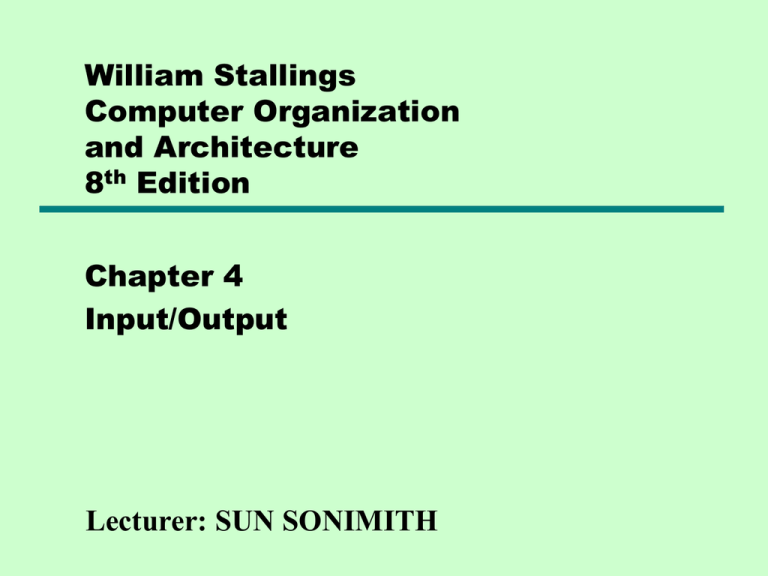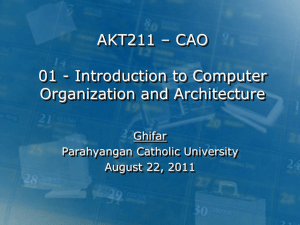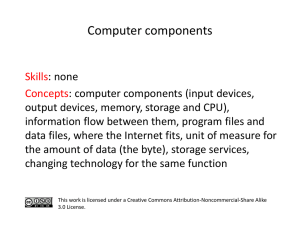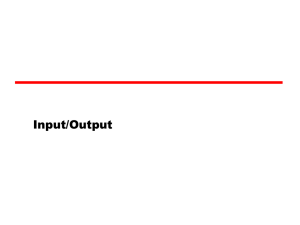07 Input Output
advertisement

William Stallings Computer Organization and Architecture 8th Edition Chapter 4 Input/Output Lecturer: SUN SONIMITH Input/Output Problems • Wide variety of peripherals —Delivering different amounts of data —At different speeds —In different formats • All slower than CPU and RAM • Need I/O modules Input/Output Module • Interface to CPU and Memory • Interface to one or more peripherals Generic Model of I/O Module External Devices • Human readable —Screen, printer, keyboard • Machine readable —Monitoring and control • Communication —Modem —Network Interface Card (NIC) External Device Block Diagram I/O Module Function • • • • • Control & Timing CPU Communication Device Communication Data Buffering Error Detection I/O Steps • • • • • • CPU checks I/O module device status I/O module returns status If ready, CPU requests data transfer I/O module gets data from device I/O module transfers data to CPU Variations for output, DMA, etc. I/O Module Diagram I/O Module Decisions • • • • Hide or reveal device properties to CPU Support multiple or single device Control device functions or leave for CPU Also O/S decisions —e.g. Unix treats everything it can as a file Input Output Techniques • Programmed • Interrupt driven • Direct Memory Access (DMA) Three Techniques for Input of a Block of Data Programmed I/O • CPU has direct control over I/O —Sensing status —Read/write commands —Transferring data • CPU waits for I/O module to complete operation • Wastes CPU time Programmed I/O - detail • • • • • • • CPU requests I/O operation I/O module performs operation I/O module sets status bits CPU checks status bits periodically I/O module does not inform CPU directly I/O module does not interrupt CPU CPU may wait or come back later I/O Commands • CPU issues address —Identifies module (& device if >1 per module) • CPU issues command —Control - telling module what to do – e.g. spin up disk —Test - check status – e.g. power? Error? —Read/Write – Module transfers data via buffer from/to device Addressing I/O Devices • Under programmed I/O data transfer is very like memory access (CPU viewpoint) • Each device given unique identifier • CPU commands contain identifier (address) Interrupt Driven I/O • Overcomes CPU waiting • No repeated CPU checking of device • I/O module interrupts when ready Interrupt Driven I/O Basic Operation • CPU issues read command • I/O module gets data from peripheral whilst CPU does other work • I/O module interrupts CPU • CPU requests data • I/O module transfers data Simple Interrupt Processing Program Status Word CPU Viewpoint • Issue read command • Do other work • Check for interrupt at end of each instruction cycle • If interrupted:—Save context (registers) —Process interrupt – Fetch data & store • See Operating Systems notes Design Issues • How do you identify the module issuing the interrupt? • How do you deal with multiple interrupts? —i.e. an interrupt handler being interrupted Identifying Interrupting Module (1) • Different line for each module —PC —Limits number of devices • Software poll —CPU asks each module in turn —Slow Identifying Interrupting Module (2) • Daisy Chain or Hardware poll —Interrupt Acknowledge sent down a chain —Module responsible places vector on bus (vector is a signal responded from I/O module) —CPU uses vector to identify handler routine • Bus Master —Module must claim the bus before it can raise interrupt —e.g. PCI & SCSI Multiple Interrupts • Each interrupt line has a priority • Higher priority lines can interrupt lower priority lines • If bus mastering only current master can interrupt Direct Memory Access • Interrupt driven and programmed I/O require active CPU intervention —Transfer rate is limited —CPU is tied up • DMA is the answer DMA Function • Additional Module (hardware) on bus • DMA controller is capable of mimicking the processor and, indeed, takes over from CPU for I/O • It needs to do this to transfer data to and from memory over the system bus. For this purpose, the DMA module must use the bus only when the processor does not need it, or it must force the processor to suspend operating temporarily. The latter technique is more common and is referred to as cycle stealing, because the DMA module steals a bus cycle. Typical DMA Module Diagram DMA Operation • CPU tells DMA controller:—Read/Write —Device address —Starting address of memory block for data —Amount of data to be transferred • CPU carries on with other work • DMA controller deals with transfer • DMA controller sends interrupt when finished DMA Transfer Cycle Stealing • DMA controller takes over bus for a cycle • Transfer of one word of data • Not an interrupt —CPU does not switch context • CPU suspended just before it accesses bus —i.e. before an operand or data fetch or a data write • Slows down CPU but not as much as CPU doing transfer DMA and Interrupt Breakpoints During an Instruction Cycle • The figure shows where in the instruction cycle the processor may be suspended. In each case, the processor is suspended just before it needs to use the bus. The DMA module then transfers one word and returns control to the processor. Note that this is not an interrupt; the processor does not save a context and do something else. Rather, the processor pauses for one bus cycle. The overall effect is to cause the processor to execute more slowly. Nevertheless, for a multiple-word I/O transfer, DMA is far more efficient that interrupt driven or programmed I/O. DMA Configurations (1) • Single Bus, Detached DMA controller • Each transfer uses bus twice —I/O to DMA then DMA to memory • CPU is suspended twice DMA Configurations (2) • Single Bus, Integrated DMA controller • Controller may support >1 device • Each transfer uses bus once —DMA to memory • CPU is suspended once DMA Configurations (3) • Separate I/O Bus • Bus supports all DMA enabled devices • Each transfer uses bus once —DMA to memory • CPU is suspended once Intel 8237A DMA Controller • • • Interfaces to 80x86 family and DRAM When DMA module needs buses it sends HOLD signal to processor CPU responds HLDA (hold acknowledge) — DMA module can use buses • E.g. transfer data from memory to disk 1. Device requests service of DMA by pulling DREQ (DMA request) high 2. DMA puts high on HRQ (hold request), 3. CPU finishes present bus cycle (not necessarily present instruction) and puts high on HDLA (hold acknowledge). HOLD remains active for duration of DMA 4. DMA activates DACK (DMA acknowledge), telling device to start transfer 5. DMA starts transfer by putting address of first byte on address bus and activating MEMR; it then activates IOW to write to peripheral. DMA decrements counter and increments address pointer. Repeat until count reaches zero 6. DMA deactivates HRQ, giving bus back to CPU I/O Channels As computer system have evolved, there has been pattern of increasing complexity and sophistication of individual components. This is more evident in the I/O function. These can be summarized as follows: 1. CPU directly controls a peripheral device (seen in simple microprocessorcontrolled devices) 2. A controller or I/O module is added. The CPU uses programmed I/O without interrupts. I/O Channels (cont.) 3. The same configuration as in step 2 but now interrupts are employed. 4. The I/O module is given direct access to memory via DMA. It can now move a block of data to or from memory without involving the CPU, except at the beginning and end of the transfer. 5. The I/O module is enhanced to become a processor in its own right, with a specialized instruction tailored for I/O. 6. The I/O module has a local memory of its own and is, in fact a computer in its own right. I/O Channels (cont.) As one proceeds along this evolutionary path, more and more of the I/O function is performed without CPU involvement. The CPU is increasingly relieved of I/O related tasks, improving performance. With the last two steps (5-6), a major change occurs with the introduction of the concept of an I/O module capable of executing a program. The I/O module is often referred to as an I/O channel. Characteristics of I/O Channels The I/O channel represents an extension of the DMA concept. An I/O channel has the ability to execute I/O instructions, which gives it complete control over I/O operations. In a computer system with such devices, the CPU does not execute I/O instructions. Such instructions are stored in main memory to be executed by a special-purpose processor in the I/O channel itself. Thus, the CPU initiates an I/O transfer by instructing the I/O channel to execute a program in memory. The program will specify the device(s), the area(s) of memory for storage, priority, and actions to be taken for certain error conditions. The I/O channel follows these instructions and controls the data transfer. Review Questions • What is ASCII code? • What are the major functions of an I/O module? • List and briefly define three techniques for performing I/O. • When a device interrupt occurs, how does the processor determine which device issued the interrupt? • When a DMA module takes control of a bus, while it retains control of the bus, what does the processor do?









